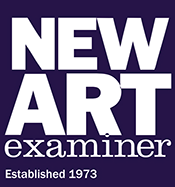
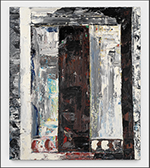

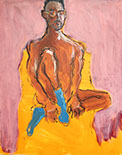

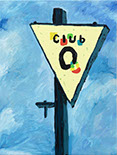
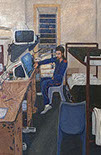
Richard Hull: “Mirror and Bone”
at Western Exhibitions
by Evan Carter
In spite of repeated claims over the decades that painting is dead, the art world currently finds itself enamored with the medium yet again. The trend as of late has been a return to the figurative, and artists and curators have endeavored to remake the art historical canon by way of representing once marginalized groups at both ends of the brush. Abstraction is also still alive and well in its expansive aesthetic modality and the commercial friendly innocuousness that it offers collectors. This is perhaps why it is still a rare and refreshing thing to encounter a painter whose work has managed to remain aesthetically interesting, yet challenging, throughout its evolution. This quality is on full display in "Mirror and Bone," a presentation of Richard Hull’s recent paintings at Western Exhibitions.
Richard Hull is often associated with the Chicago Imagists and considered by many to be continuing the groups legacy. The figurative nature of Hull’s work does share similarities with the amoeba like figures of Jim Nutt, but Hull’s work is grounded in a more traditional “brush to canvas” form of painting that differs from the enameled signboard quality of Nutt’s work. Allusions to the weighty and brushstroke heavy forms of Philip Guston are also often made but differ in the way Hull constructs forms that evoke the psychedelic and microbiologic. It is almost as if he was, and still is, more comfortable incorporating the design aesthetics of the 60’s and 70’s than that of his predecessors whose work defined those decades.
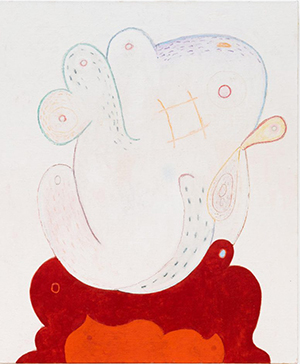
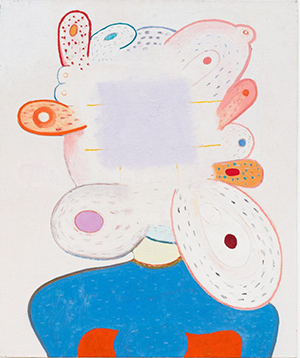
Richard Hull (left), Nurse, 2020. Oil and wax ground on linen, 24h x 20w inches. (right) Doc, 2020. Oil and wax ground on linen, 24h x 20w inches. Photos: Western Exhibitions.
What is most striking about these recent paintings is their expansion of Hull’s approach to figuration. His is known for his “portraits” which have often consisted of bulbous heads comprised of aggregated round shapes that seem to exist simultaneously as liquidous tumors, exaggerated haircuts, and bacterial structures. “Mirror and Bone” provides viewers with many windows into the world of these strange figures but does so with more variation in color and mark than previously seen in Hull’s work. Until now his palette has been dominated by blacks, blues, and saturated reds and oranges. Pieces like Nurse and Doc feature more air with white forms outlined in pastels that feel as clinical as their titles. Choices by Hull to limit his palette lend an iconic and monumental quality to what seem to be the flagship pieces of the exhibition in gallery two. Three of these works in particular—Sync, Cataract, and Breath—are the largest works and are dominated by pink. Variation in hue ranging from pale lily to blood red evoke the fleshy interior of the human body, confronting the viewer with other worldly figures that are simultaneously frightening as they are resonant with our own bodily experience.
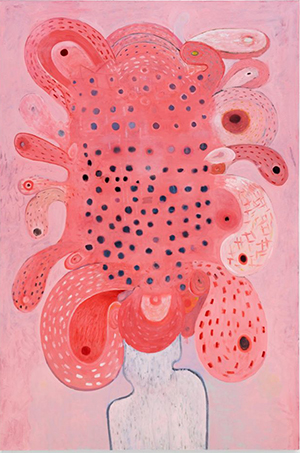
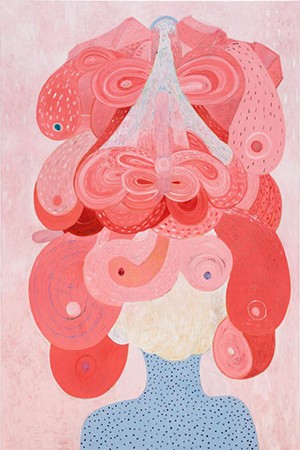
Richard Hull lLeft), Sync, 2022. Oil and wax ground on linen, 72h x 48w inches. (right) Cataract, 2022. Oil and wax ground on linen, 72h x 48w inches. Photos: Wesstern Exhibitions.
Another recent trend in contemporary painting is the influence of the digital on subject matter, application, and color choice. Hard lines, electrifying hues, smooth gradients, and figures devoid of humanity are prevalent. Hull’s work in “Mirror and Bone” bucks many of these trends but nevertheless feels of the moment. Simple titles like Pressure and The Sleep utilize shape and color to tap into the universal themes that feel redefined in the twenty-first century. These are just two examples in which Hull’s usual neutral or earthy tones are punctuated with bright pinks, blues, and greens, as if he is telling the story of the digital world seeping into the organic one that he has depicted for decades; it establishes him as a painter whose work has not been entirely subsumed by the screen.
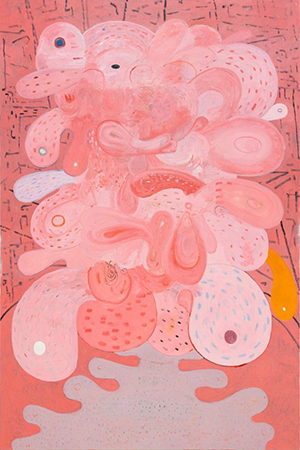
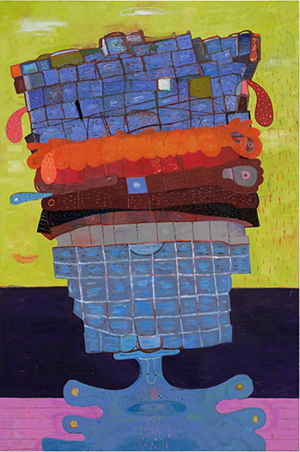
Richard Hull (left), Breath, 2021. Oil and wax ground on linen, 72h x 48w inches. (right) Pressure, 2022. Oil and wax ground on linen, 72h x 48w inches. Photos: Wesstern Exhibitions.
Hull’s renderings of interior and architectural spaces are also not to be ignored. Two mixed media drawings, Teller and Crossing, are cleverly on display between rooms across from the gallery office desk. These differ from many of Hull’s earlier depictions of space in their airy palette and inclusion of his organic figurative forms that occupy these spaces and are perhaps fused with them. Teller feels the most cohesive as a space with its blue floorboards, ochre colored curtain, and patterned window frame that borders a vista of pink hills and green water off in the distance. These less formalized compositions seem to offer insight into the artist’s thought process and intuitive mode of working that feels more refined in the paintings. There is a generosity to the inclusion of these works which speaks to the kind of artist being featured here.
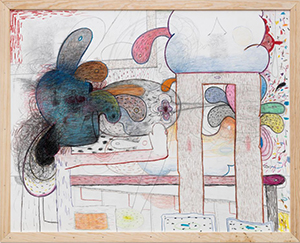
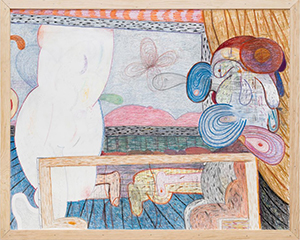
Richard Hull (left), Crossing, 2023. Pencil, coloured pencil, charcoal, and crayon on paper, 30h x 38w inches. (right) Teller, 2023. Coloured pencil, charcoal, and crayon on paper, 30h x 38w inches. Photos: Wesstern Exhibitions.
When observing the many facets of the range of work in “Mirror and Bone,” it is easy to see that Richard Hull is telling us a story. It is a story that occupies a vast world, not just of beings and spaces but of activity and sensation. What is missing is emotion. This is not entirely a fault in the work but more likely an asset. These strange figures and lilted spaces are beacons to our own emotional experiences within the world we live in. The world of “Mirror and Bone” may look foreign to us but much like the most resonant paintings throughout our history they act as both mirror and window. It is the potential for what we can discover in this liminal space that makes “Mirror and Bone” so worth seeing.
Evan Carter is a visual artist and assistant editor of the New Art Examiner. He joined the team in 2017 while earning an MFA from the University of Chicago and has been covering arts and culture in the city and beyond ever since. He is invested in the creative community and its capacity to make meaning and reveal truth in everyday life.